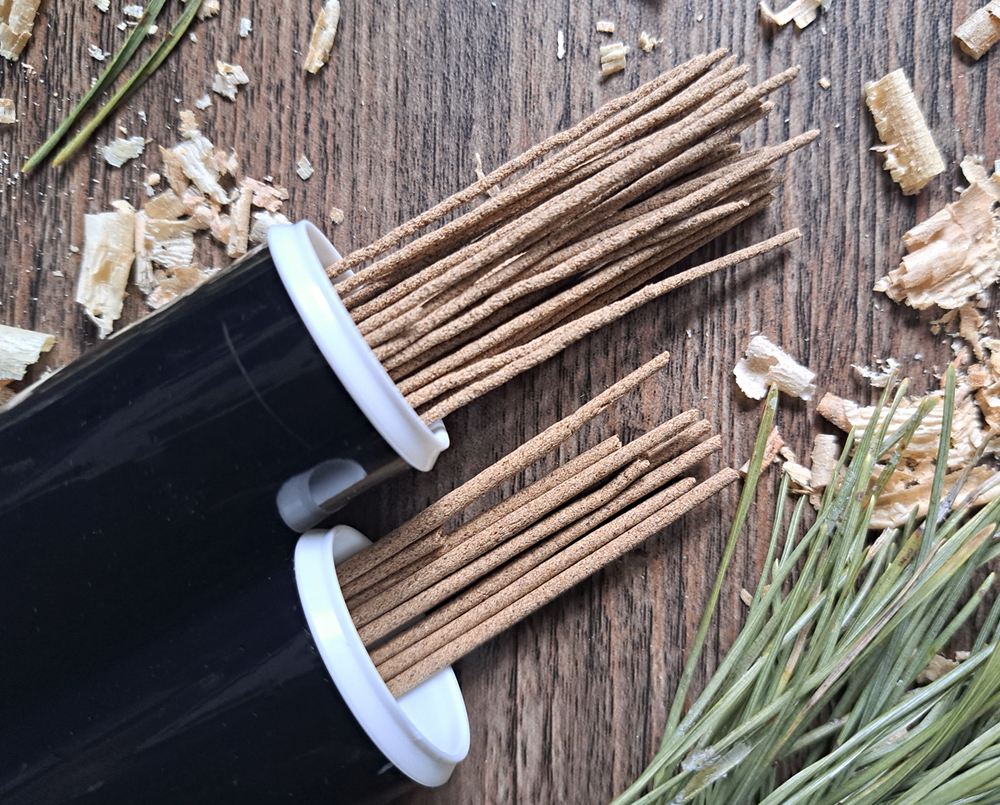Swiss Stone Pine Incense Sticks
This recipe is to be understood as an example. It contains, among other things, ingredients that you cannot buy but can be replaced with others. You can find a list of suppliers at the end of the article.
It may not be the most appropriate first recipe to share, but so be it.
I have now given away a few samples and have already received some very positive feedback.
For details on the tools and materials required, please see my article:
In the recipes published here, I primarily want to focus on their specific features and explain how and why I composed them the way they are.
I assume a basic knowledge of incense stick making. Steps that are the same for every recipe, such as grinding and sifting, will not be described every time.
| Ingredients | Grams |
|---|---|
| Swiss stone pine wood | 3.6 |
| Orris root | 0.8 |
| Pine resin | 1 |
| Sal resin | 0.4 |
| Benzoin Siam | 0.2 |
| Resinous black pine bark | 0.6 |
| Laha | 2.2 |
| Tragacanth | 0.2 |
| Stone Pine essential oil 6 drops | |
| Honeydew honey 1 drop | |
| Distilled water | |
| In total | 9 |
| % resin content | 17.8 |
| % share of binder | 26.7 |
Note: These recipes are my intellectual property.
I allow private use, but I prohibit commercial use and distribution.
I worked on this recipe for a few weeks.
On an incense heater, Swiss stone pine wood smells quite mild and pleasant. When it’s burned, it quickly gives off a somewhat pungent smell of wood smoke. Nevertheless, I wanted to create a pleasant incense stick out of it so that I didn’t always have to resort to exotic ingredients.
I got the stone pine wood chips as a gift from a wood turner, but you can also buy them online in many places (at least here in Germany and neighbouring Countries).
It was a large box full, which had the advantage that there was a considerable amount of fine powder in it, that I just had to sift out. If you buy chips, you have to grind them (preferably using a blade grinder) and sieve the powder. This can take quite a while.
My first impulse was to combine the pine wood with sandalwood to make it milder, but that didn’t work. The smell was still just as scratchy, just with less of a pine smell.
Only the addition of resin made the smell more rounded.
I discarded the sandalwood again; it was too expensive for the purpose because you could hardly smell it in the end product, so I considered it a waste.
I harvested the pine resin myself. Brittle, fully cured and well aged resin that was easy to pulverize. It comes from Scots pines and black pines.
The resinous black pine bark was also foraged by me; you won’t find it in stores. Bark in general smells darker than wood, slightly warmer and adds in a slight sweetness with the resin.
You can replace it with more wood, more orris root or another similar ingredient; creativity is required here.
To soften the smell a little further, I chose orris root. It has a powdery, slightly floral, violet-like scent and has a fixating effect on other smells – a big advantage, especially because some essential oil is used as well in this recipe.
Siam benzoin is sweet. I added this tiny amount to make the composition a little more “approachable”, the smell was too dry for me without it.
Sal, also a resin, has a complex and peculiar smell: somewhat earthy, resinous-balsamic and kinda sour. This small amount gives the recipe a little more depth.
Laha is the main binder in this recipe. I added 0.2g of tragacanth after rolling the first test stick because I found the result was a bit too fragile.
If you use essential oil in incense sticks, add it at the end while mixing the dough.
The same applies to honey.
For such small batches, I dose it by dipping a toothpick about a quarter of the way into the honey, and what sticks to it is the amount I use.
The first two batches, which I wasn’t entirely happy with, I extruded with the second-smallest nozzle in my set and rolled the noodles a little thinner. This has in some cases led to them becoming hollow inside. This makes them more fragile and creates unintentional “backflow” effects – the smoke is drawn in and then flows out through a weak point on the stick.
I extruded this recent batch with the finest nozzle. I was very surprised that it worked. The finished sticks have a diameter like some round-cut bamboo splints of Indian incense sticks.
They are of course a little more fragile than the thicker ones, but still OK. Unfortunately, they burn down rather quickly. That means next time I will choose a larger diameter again.

Above the thinner, 3rd batch; below the 2nd.
If you use this recipe for inspiration, I would be delighted to receive feedback with criticism and your experiences.
Sources of Supply:
- Orris root (powder) – purchased from YouHerbIt!, which can also be found on Etsy.
- Siam benzoin, sal – for example at Sonnlicht.de
you can also buy pine resin there. There is also resin from the Siberian pine (Pinus cembra sibirica), but in my experience this is not significantly different from that of our native Scots pine. The typical, unique stone pine scent is only created in combination with stone pine wood.
Jeomra is also a good place for these resins. - Laha – Jarguna on Etsy. This Italian vendor specializes primarily in resins and the quality is largely outstanding.
- Swiss stone pine oil, tragacanth (powder) – Dragonspice.de is where I got both my current ones from.
However, I think the Swiss stone pine oil from the brand Primavera (can be found in many health food stores) is better.

